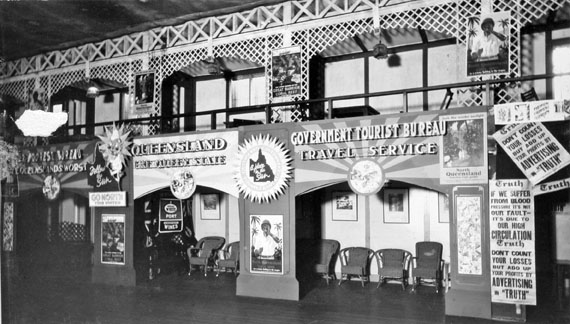Trocadero Dansant in South Brisbane

On the evening of 31 May 1923 the Governor, Sir Matthew Nathan opened the high-class dance palace, Trocadero Dansant in Melbourne Street, South Brisbane. It soon became popular with dancers and spectators. A major feature was the highly-polished dance floor, the first of its kind in Australia which was modelled on the design of a New York Dance Palais , with room for up to 1200 dancers. After exhausting themselves on the dance floor, dancers could rest in the 52 vine-clad alcoves .

After its spectacular opening on 31 May 1923 it didn’t take long for the Trocadero Dansant in South Brisbane, next to the Hotel Terminus [now the Fox Hotel] to become a popular high-class venue for dancing and socialising.
Those were the days of the Roaring Twenties, the new age of energetic dancing, of ‘flappers’ wearing short dresses and dancing like birds, flapping their arms while dancing the Charleston.

The highly-polished dance floor modelled on the New York Palais with room for up to 1200 dancers could be viewed from a spectator’s gallery above. The painted ceiling had violet and blue electric lighting. A central ‘disco-ball-like’ chandelier reflected the colour and movement of the dancers below. Hundreds of palm trees along the walls and window-boxes provided a tropical atmosphere and 52 vine-clad alcoves were welcome rest stations for exhausted dancers.

‘The Troc’ was the place to go to learn new dances such as the Charleston, French tango and the Foxtrot, as well as to dance waltzes and polkas. It was the beginning of the jazz age with swinging jazz orchestras playing the latest ragtime melodies and vocalists singing popular Hollywood songs. The Billo Smith Trocadero Orchestra was the house band for over 20 years. It was considered one of the finest ensembles in Australia during the 1920s and 1930s, renowned for its excellent musicianship, hot charts and strict tempos.
The Trocadero remained popular with locals throughout the 1930s. During the Pacific War (1942-45) it was always crowded with American servicemen who introduced the jitterbug and the jive. They were lively and fun days and the ‘Troc’ became legendary.
However, its popularity waned after the war when there were no more servicemen, and locals started going to Cloudland, the huge ballroom and dancing hall which had been opened in 1940. The Trocadero closed in April 1945 and the building was used as a technical college until it was demolished in 1971 so the site could become part of the railway line link from South Brisbane to Roma Street.
 All that’s left today is a sign under the Melbourne Street overpass, but no doubt the memories of a bygone era linger on.
All that’s left today is a sign under the Melbourne Street overpass, but no doubt the memories of a bygone era linger on.
(Trove and news articles/SLQ/Wikipedia)
Government Tourist Display at the Trocadero
Queensland Government Tourist Bureau display promoting its Travel Service at the Trocadero ca. 1932. A look inside the dance hall showing the dance floor, the alcoves and the spectator gallery above.

